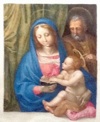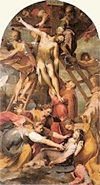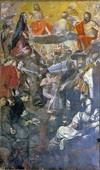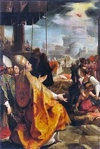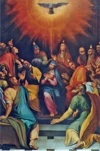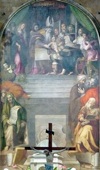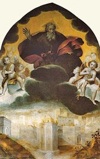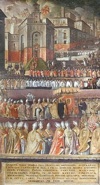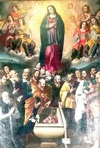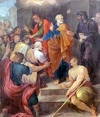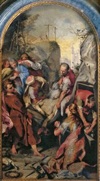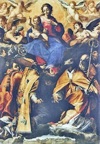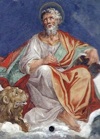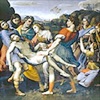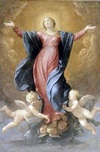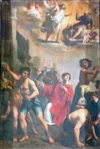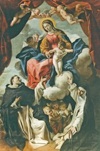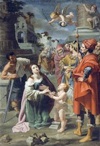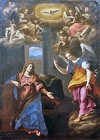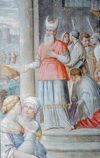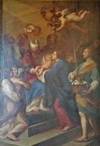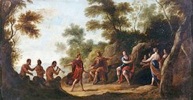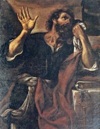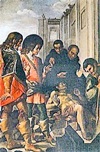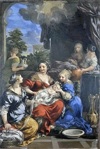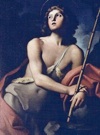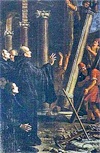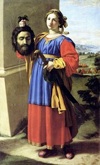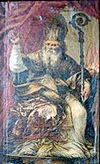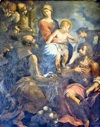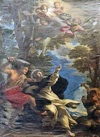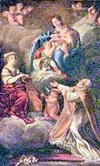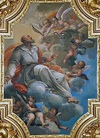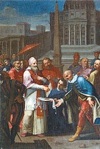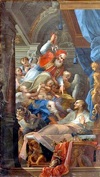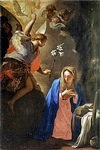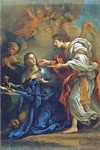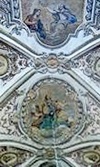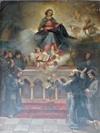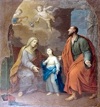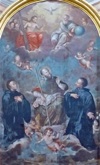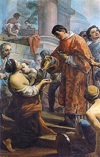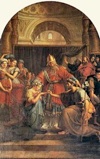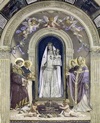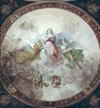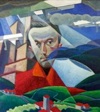Cesare Franchi, il Pollino (died ca. 1600)
Cesare Franchi was a highly regarded miniaturist based in Perugia. He was executed there for murder in ca. 1600. Five miniatures that he produced for the Confraternita dei Nobili, probably in the 1590s, are now in the Galleria Nazionale, including this one of the Holy family. A miniature of the Convento di sant’ Agostino and two in the Biblioteca, all of which probably date to the same decade, are attributed to him. One of the latter two is unfinished, presumably because it dates to the time of his arrest.
Pietro Rancanelli (died after 1602)
Pietro Rancanelli is known from only one signed work, a panel (1602) of the Madonna and Child with saints from San Clemente, Montefalco, which is now in the Pinacoteca there. He was almost certainly the “Maestro Pietro” who was documented in 1592 as an associate of Silla Piccinini (above) at San Pietro, where a number of frescoes (1592) are attributed to him. These include a series of allegorical figures, one of which is illustrated here. Other frescoes (late 16th century) are attributed to him in Palazzo Baldeschi Bonucci and the Oratorio dei Nobili of the Chiesa del Gesù.
Federico Zuccari (died 1609)
From Urbino , based in Rome
A panel (1582) of unknown provenance in the art collection of the Fondazione Cassa di Risparmio di Perugia, which is dated by inscription, is attributed to Federico Zuccari. It depicts a scene from the martyrdom of St Catherine of Alexandria.
[Temporary link to Federico Zuccari]
Federico Barocci (1535-1612)
Federico Barocci was an early exponent of the artistic requirements of the Council of Trent. This magnificent altarpiece (1569) of the Descent from the Cross, which the Collegio della Mercanzia commissioned from Federico Barocci for their chapel in the Duomo, was particularly influential with local artists. Two other panels by Barocci himself or his workshop which were originally in Perugia churches are now in museums elsewhere:
-
✴the Madonna della Ciliegia (1573) from the the Chiesa del Gesù, which is now the Pinacoteca Vaticana, Rome; and
-
✴the Madonna and Child with saints (ca. 1580) from Sant’ Agostino, which is now in the Musée du Louvre, Paris.
Vincenzo Pellegrini (died 1612)
Vincenzo Pellegrino was murdered in Perugia before his 40th birthday. His surviving works in Perugia include this altarpiece (1612) on the high altar of the Chiesa della Compagnia della Morte, which depicts the Virgin interceding for souls in Purgatory. It was painted in the year in which Pellegrini was murdered, and is his last known work.
Ventura Salimbeni (1571-1613)
From Siena, based in Rome
Ventura Salimbeni became one of the most appreciated artists of his time. His patron, Cardinal Bonifazio Bevilacqua, the Papal Legate in Umbria in the early 17th century, commissioned two panels (1602) for San Pietro:
-
✴the "Punishment of King David"; and
-
✴the "Vision of St Gregory the Great" (illustrated here).
Cardinal Bevilacqua was so pleased that he invested Salimbeni with the Order of the Golden Spur and authorised him to call himself Cavalieri Bevilacqua.
Cesare Nebbia (died 1614)
Cesare Nebbia played an active part in the redecoration of the Duomo in his native city from 1566. He also established a reputation in Rome, particularly under Pope Sixtus V (1585-90). His work in Perugia includes this altarpiece (ca. 1576) in the Cappella dello Spirito Santo of the Duomo, which depicts the events of Pentecost.
Durante Alberti (1556–1623)
From Borgo Sansepolcro, based in Rome
The panel (1575?) of the Circumcision of Christ on the high altar of the Chiesa del Gesù is sometimes attributed to Durante Alberti.
Simeone Ciburri (died 1624)
Simeone Ciburri seems to have enjoyed the patronage of Cardinal Bonifazio Bevilacqua, the Papal Legate in Umbria in the early 17th century. This documented altarpiece (1602) in the Duomo is the most important of the panels attributed to him that survive in Perugia.
Cristoforo Roncalli, il Pomarancio (1552-1626)
From Pomarance, near Volterra, based in Rome
The frescoes (early 17th century) in the cupola and pendentives of the presbytery of the ex-church of Santa Caterina Vecchia are attributed to Cristoforo Roncalli.
[Temporary link to Cristoforo Roncalli]
Matteo (Matteuccio) Salvucci (1576-1627)
Born in Bettona, based in Perugia
Matteuccio Salvucci worked mainly in fresco in Perugia, and developed an idiosyncratic style. His last work was a set of four panels (ca. 1627) in Sant’ Ercolano, which included this interesting depiction of the translation of the relics of St Herculanus from the Duomo to Sant’ Ercolano in 1609.
Ippolito Borghesi (died 1627)
Born in Sigillo, near Perugia, worked mainly in Naples
The jurist Pierantonio Ghiberti commissioned an altarpiece (1620) of the Assumption of the Virgin (illustrated here) from Ippolito Borghese for his funerary chapel in the Duomo. Two other panels in Perugia are attributed to him: one in the Galleria Nazionale; and one in the Collection of the Fondazione Cassa di Risparmio di Perugia.
Avanzino Nucci (died 1629)
Probably from Gubbio, based in Rome
Avanzino Nucci was a follower of of Nicolò Circignani, il Pomarancio. The following works in Perugia are by or attributed to him:
-
✴St Albert (1607) in San Simone del Carmine, [which is signed and dated by inscription]; and
-
✴two works (early 17th century) in the Collection of the Fondazione Cassa di Risparmio di Perugia:
-
✴St Peter and Simon Magi (illustrated here); and
-
✴St Peter converting the centurion Cornelius.
Felice Pellegrini (died after 1630)
Felice Pellegrini, the older brother of Vincenzo Pellegrini (above), was a close follower of Federico Barocci. His only surviving work in Perugia is the altarpiece (1593) of the Oratorio del SS Crocifisso in Santa Maria Nuova, which depicts the Deposition of Christ. It is a copy of the altarpiece (1592) by Federico Barocci in the Chiesa della Croce, Senigallia.
Giovanni Antonio Scaramuccia (died 1633)
Giovanni Antonio Scaramuccia was the most important artist in Perugia in the early 17th century. A number of his panels survive in the city, including this panel (1617) of the Madonna and Child in glory with saints, which is now on the counter-facade of the Duomo.
This page also contains a short account of the work of his son, Luigi Pellegrini Scaramuccia (1616-80).
Benedetto Bandiera (1557-1634)
The surviving works by or attributed to Benedetto Bandiera in Perugia include a number undertaken in San Pietro in the period 1590-1619. These include the frescoes of the Evangelists in the vaults of the apse, one of which (St Mark) is illustrated here.
Giuseppe Cesari, il Cavalier d’ Arpino (1568-1640)
From Arpino, based in Rome
The Cavalier d’ Arpino was probably the most important artist in Rome during first two decades of the 17th century. He secured the patronage of Pope Clement VIII, who knighted him, and of Pope Paul IV. This copy (1609) of Raphael’s Baglioni Deposition (1507) is attributed to him. Cardinal Scipione Borghese commissioned it to replace the original in San Francesco al Prato, which he purchased and took to Rome. The copy is now in the Galleria Nazionale.
Guido Reni (1575-1642)
Guido Reni established his career in Rome under the patronage of the Borghese family, before returning to his native Bologna in 1613. This important altarpiece (1637) of the Assumption of the Virgin from San Filippo Neri was taken to France in 1797 and is now in the Musée des Beaux Arts, Lyon. An altarpiece (17th century) of the Agony in the Garden in Cappella Ranieri, San Pietro is attributed to him.
Stefano Amadei (1589-1644)
Stefano Amadei was a mathematician as well as an artist. He apparently made a copy (ca. 1608) of the upper panel of Raphael’s Baglioni Altarpiece (1507), which is probably this panel in the Galleria Nazionale.
Giovanni Baglione (1573-1644)
Giovanni Baglione was an important painter in Rome and an art historian. He is best remembered for his biographies of his contemporary artists. Two panels in Perugia are by or attributed to him:
-
✴Martyrdom of St Stephen (ca. 1608), illustrated here; and
-
✴St Martin and the Beggar (ca. 1630), which now forms part of the Collection of the Fondazione Cassa di Risparmio di Perugia.
Ferraù Fenzoni (1562-1645)
From Faenza
Bishop Angelo Cesi called Ferraù Fenzoni from Rome to Todi in 1593. He remained there until 1599, when he returned to Faenza. While in Todi, he accepted commissions from other cities in Umbria. The altarpiece (late 16th century) of the Martyrdom of St Laurence in the Sacrestia dell’ Arciprete of the Duomo, which was the burial chapel of Cardinal Fulvio della Corgna, is by Ferraù Fenzoni.
[Temporary link to Ferraù Fenzoni]
Giovanni Lanfranco (1582-1647)
From Parma, based in Rome, then Naples
Giovanni Lanfranco was among the most important artists working in Rome for almost two decades until 1631, the year in which he became the Principal of the Academy of St Luke. He subsequently moved to Naples but returned to Rome shortly before his death. His altarpiece (1647) of the Madonna and Child with saints in San Domenico was probably painted in Naples.
Girolamo Martelli (died after 1647)
From Assisi
Almost all of the known and attributed works of Girolamo Martelli are in his native city, where he often worked with Cesare Sermei (see below). Both artists were responsible for the frescoes (17th century) in the vaults of the Oratorio dei Nobili of the Chiesa del Gesù.
Antonio Maria Fabrizi (1595-1649)
Antonio Maria Fabrizi, who probably trained in Rome, subsequently worked in his native city and left his work in a number of churches there. These include San Domenico: this panel (1630) of the martyrdom of St Dorothy is one of two that he painted for the Cappella del Rosario there, which are now in the left transept.
Giovanni Francesco Bassotti (died 1649)
Works in Perugia by or attributed to Giovanni Francesco Bassotti include this panel (17th century) of the Annunciation in Santa Teresa degli Scalzi.
Andrea Camassei (1602–1649)
From Bevagna, based in Rome
Andrea Camassei, who enjoyed a successful career in Rome, also maintained links with his native Bevagna.
A panel (17th century) in the art collection of the Fondazione Cassa di Risparmio di Perugia, which depicts Cain killing Abel, is attributed to him.
Bernardino Gagliardi (died 1660)
Bernardino Gagliardi established a workshop in Perugia. He died in the city in 1660 and was buried in San Domenico. His surviving work here includes:
-
✴the frescoes (1649) in the Cappella della Purificazione, San Filippo Neri, which include this one of St Simeon awaiting the arrival of the Virgin and St Joseph at the Temple;
-
✴three panels (1656) that conclude a series of scenes from the lives of Christ and of SS Philip and James in the Oratorio di Sant’ Agostino;
-
✴two panels (1657) depicting SS Dominic and Augustine in the Oratorio di San Francesco; and
-
✴the altarpiece (17th century) of St Helen and the Holy Cross on the Altare della Compagnia degli Oltremontani in Santa Maria Nuova.
Andrea Sacchi (1599-1661)
Andrea Sacchi trained under Pietro da Cortona, but later moved away from his exuberant style. Most of his surviving works are in Rome. Two works by or attributed to him survive in Perugia:
-
✴this altarpiece (1651) of the Purification of the Virgin from San Filippo Neri, which is now in the Galleria Nazionale; and
-
✴a portrait (17th century) of Taddeo Barberini in Palazzo della Penna, which is attributed.
Francesco Allegrini (1624-84)
From Rome, based in Gubbio in 1661-81
Francesco Allegrini established his career in Rome before moving to Gubbio. Two panels (17th century) in the art collection of the Fondazione Cassa di Risparmio di Perugia are attributed to Francesco Allegrini. They depict:
-
✴the taking of auguries that led to the foundation of Rome by Romulus and Remus; and
-
✴Marsyas’ challenge to Apollo (illustrated here).
Giovanni Francesco Barbieri, il Guercino (1591-1666)
From Cento, near Bologna, based in Bologna
Panels (17th century) in San Pietro that are attributed to this prolific Baroque artist depict St Peter (illustrated here) and St Paul.
Cesare Sermei (1584- 1668)
From Orvieto; trained in Rome; moved to Assisi
Works in Perugia by or attributed to Cesare Sermei include:
-
✴frescoes (1620) in the vault of the nave of the ex-church of Santa Caterina Vecchia;
-
✴frescoes (1630) in the ex-church of Santa Maria Maddalena delle Repentute;
-
✴an altarpiece (1648) of St Maurus raising a man from the dead in the Abbazia di San Pietro (illustrated here); and
-
✴frescoes (17th century) in two of the oratories of the Chiesa del Gesù:
-
•in the vaults of the Oratorio dei Nobili (with Girolamo Martelli, see above); and
-
•at the centre of the ceiling of the Oratorio degli Artisti.
Pietro da Cortona (1596-1669)
From Cortona, based in Rome
Pietro da Cortona was one of the leading Baroque artists in Rome. His surviving works in Perugia include:
-
✴an altarpiece (1643) of the Birth of the Virgin from San Filippo Neri, which is now in the Galleria Nazionale (illustrated here); and
-
✴two depictions of St Martina’s Vision of the Madonna and Child:
-
•a preparatory model (ca. 1644) in Palazzo della Penna, which was for a relief on the ciborium of SS Luca e Martina, Rome; and
-
•a small panel (ca. 1647) in the Galleria Nazionale, which is of unknown provenance; and
-
✴an altarpiece (1658-62) of the Immaculate Conception, which remains on the high altar of San Filippo Neri.
Giovanni Domenico Cerrini (1609-81)
Giovanni Domenico Cerrini (il Cavalier Perugino), who trained under Giovanni Antonio Scaramuccia (above), moved to Rome in 1638 and made his career there. His few works in his native city include two panels (ca. 1660) in the Abbazia di San Pietro, one of which (the young St John the Baptist) is illustrated here.
Giacinto Gimignani (1606-81)
Giacinto Gimignani was documented in Rome from 1630 as an associate of Pietro da Cortona. Three panels by Giacinto Gimignani survive in the Abbazia di San Pietro:
-
✴a panel (1677) depicting the Miracle of the Column (illustrated here); and
-
✴two panels (1679) depicting of scenes from the Life of St Benedict.
Giovanni Battista Salvi, il Sassoferrato (1609-85)
From Sassoferrato, worked mainly in Rome
This prolific artist worked mostly on copies of older paintings and on small devotional works. He worked for a period in Perugia, mostly in San Pietro, in the 1630s. His surviving works there include this panel (17th century) of Judith and Holofernes.
Paolo Gismondi (died 1685)
From Perugia, worked mainly in Rome
Paolo Gismondi trained under Giovanni Antonio Scaramuccia before moving to Rome in the 1630s. Works by or attributed to him in his native city include:
-
✴an altarpiece (ca. 1650) depicting St Antony Abbot in Sant’ Antonio Abate (illustrated here);
-
✴two panels (ca. 1665) depicting SS Francis and Louis of Toulouse in the Oratorio di Sant’ Francesco; and
-
✴a lunette-shaped panel (ca. 1665) depicting the Birth of the Virgin the Oratorio degli Artisti in the Chiesa del Gesù.
Pietro Montanini (1626-89)
Works by or attributed to Pietro Montanini that survive in Perugia include this altarpiece (1674) of the Madonna and Child with saints on the altar of the Oratorio dei SS Simone e Fiorenzo.
Giovanni Andrea Carlone, il Genovese (1639-97)
From Genoa
Giovanni Andrea Carlone spent much of the early part of his career in Umbria. His works survive in a number of churches in Perugia, including the Chiesa del Gesù, San Filippo Neri and Sant’ Ercolano. The surviving works in this last church include these frescoes (1675) in the cupola of St Paul in glory with other saints.
Giovanni Ventura Borghesi (1640-1708)
From Città di Castello
Giovanni Ventura Borghesi trained in Rome from ca. 1662 in the workshop of Pietro Berrettini da Cortona, and worked in there until ca. 1685, when he returned to his native city. This altarpiece (1705) that he painted for the Cappella di San Pietro Martire in San Domenico is a copy of the now-lost altarpiece (1528-30) of the death of St Peter Martyr in SS Giovanni e Paolo, Venice.
Carlo Lamparelli (died 1727)
Carlo Lamparelli served as Prior of Santa Maria Maggiore, Spello from 1716 until his death. Little else is known about him, although he probably trained in Rome. The Oratorian Fathers of San Filippo Neri commissioned this altarpiece (1688) from him for the Oratorio di Santa Cecilia. It depicts the Madonna and Child with SS Cecilia and Philip Neri. An altarpiece (ca. 1700) of the Transfiguration of St Theresa in Santa Teresa degli Scalzi is attributed to him.
Mattia Batini (1666-1727)
From Città di Castello, citizen of Perugia from 1713
Mattia Batini trained under Pietro Montanini (above). His most accomplished works were three panels (1700) in the ceiling of the Oratorio di Sant’ Agostino, which include this one of St Philip in glory. Other works by or attributed to him survive in: San Domenico; Santa Spirito; and Santa Caterina.
Giuseppe Laudati (1669-1737)
From Corciano, citizen of Perugia
Several works by Giuseppe Laudati survive in his native Corciano. Panels by or attributed to him also survive in Perugia: in San Domenico (including this panel (ca. 1730) of Pope Pius V and the Polish Ambassador); in Santa Giuliana; and in San Giovanni di Dio.
Giacinto Boccanera (1666-1746)
From Leonessa; trained in Rome; based in Perugia
Works in Perugia by or attributed to Giacinto Boccanera include this altarpiece (ca. 1730) depicting a miracle of St Pius V, which is in the Cappella di San Pio V, San Domenico.
Francesco Trevisani (1656-1746)
From Capodistria, near Trieste; trained in Venice; based in Rome
Francesco Trevisani established a successful career in Rome from ca. 1678 until his death. His work in Perugia includes: :
a panel (ca. 1708) of the Martyrdom of St Andrew in the Galleria Nazionale, which from the Carattoli Collection, and which is a copy by Francesco Trevisani of the panel that he painted before 1708 for the presbytery of Sant’ Andrea delle Fratte, Rome; and
a panel (1710) of the Annunciation in San Filippo Neri (illustrated here).
Francesco Mancini (1679-1758)
From Sant’ Angelo in Vado, Pesaro; based in Rome
Works in Perugia by or attributed to Francesco Mancini include:
-
✴a fresco (1728-30) of the Coronation of the Virgin the cupola of San Filippo Neri;
-
✴an altarpiece (ca. 1730) of St John the Baptist in the Museo Diocesano, which is a replica of an one that Francesco Mancini sent from Rome to Fano in 1726 in thanks for having been given citizenship there; and
-
✴an altarpiece (1732) of the Virgin with SS Anna and Joacchim from Santa Teresa degli Padri Scalzi, which is now in the Galleria Nazionale.
Sebastiano Conca (1680–1764)
From Gaeta; based in Rome in 1706-52
This altarpiece (1738) by Sebastiano Conca, which came from Santa Maria Maddalena delle Repentute and which depicts the Communion of St Mary Magdalene, is now in the Galleria Nazionale. So too are two panels (1731) from Palazzo Della Corgna, Città della Pieve. A panel (18th century) of the Visitation in the sacristy of San Pietro is also attributed to him.
Francesco Busti (1678-1767)
Francesco Busti trained in Rome and then Venice before establishing a long career in his native Perugia. His biographer, Baldassarre Orsini judged his altarpiece (1730) of a Miracle of St Vincent Ferrer in San Domenico (illustrated here) to be his best work. Other panels in the Chiesa della Morte and in Santo Spirito are by or attributed to him.
Paolo Brizi (1702-73)
Born in Fano, settled in Perugia in 1735
Paolo Brizi was called to Perugia in 1735 to work at San Filippo Neri. He subsequently established a career here, specialising in decorative frescoes, and often worked in association with figurative artists. His surviving works in the city also include these frescoes (1752) in the ex-Oratorio di Sant’ Anna.
Ludovico Mazzanti (1686–1775)
Born in Rome, based there and also in Orvieto
Ludovico Mazzanti had close links with Orvieto, his father’s native city. He trained in Rome and spent most of his career there. In Perugia, he painted the panel (1746) of St Bernard Tolomei helping victims of plague for the the Monastero degli Olivetani di Montemorcino Nuovo. This panel is now in the deposit of the Galleria Nazionale.
[Temporary link to Ludovico Mazzanti]
Gaetano Lapis (1704-76)
From Cagli, based mostly in Rome
Gaetano Lapis trained under Sebastiano Conca in Rome the 1720s and subsequently established a successful career there. Works in Perugia that are by or attributed to him include:
-
✴an altarpiece (1734) of the Madonna and Child with saints on the high altar of the Oratorio dei SS Andrea e Bernardino; and
-
✴an altarpiece (1761-3) of the Ecstasy of Saint Joseph of Copertino for San Francesco al Prato [where is it now?].
[Temporary link to Gaetano Lapis]
Etienne Parrocel, il Romano (1696-1776)
From Avignon; based in Rome
A panel (1745) in the Collection of the Fondazione Cassa di Risparmio di Perugia, which is signed by Etienne Parrocel and dated by inscription, depicts a woman who represents the New Testament repelling heretics.
[Temporary link to Etienne Parrocel]
Francesco Appiani (1704-93)
From Ancona; trained in Rome; based in Perugia from 1743
The large number of works by Francesco Appiani that survive in Perugia include this altarpiece (1740) in Santa Maria Nuova, which depicts the Madonna in glory with saints. He was also among the artists that Bishop Alessandro Maria Odoardi (1776-1805) employed to decorate the Duomo.
Antonio Maria Garbi (1718-97)
From Tuoro sul Trasimeno, based in Perugia
Works by or attributed to Antonio Maria Garbi in Perugia include this panel (18th century) of the Virgin with SS Anne and Joachim in the sacristy of Sant’ Ercolano.
Cristoforo Gasperi (1716-1804)
From Magione, settled in Perugia at an early age
Cristoforo Gasperi trained in Perugia under Giacinto Boccanera (above) and then in Rome. He spent the rest of his career in Perugia. He painted this altarpiece (1788) of the Trinity and St Francis di Sales with the recently beatified Gaspare da Valenza and Leonardo de Longobardis in Santo Spirito. Other works attributed to him survive in: [Sant’ Angelo in Porta Eburnea]; the Chiesa della Morte; and [Santa Maria di Colle].
Baldassarre Orsini (1732-1810)
Baldassarre Orsini was an artist, an architect and a writer. Two panels that he painted for the Duomo are now in the Museo Capitolare:
-
✴St Laurence distributing arms (1767) (illustrated here); and
-
✴the martyrdom of St Laurence (1768).
Jean Baptiste Wicar (1762-1834)
From Lille, based in Rome
This artist had close links with the Napoleonic courts of Italy, but managed to continue his successful career in Rome after the fall of Napoleon. He had close links with Perugia: his altarpiece (1825) of the Marriage of the Virgin survives in situ in the Duomo there.
Mariano Piervittori (1815-88)
From Tolentino, moved to Foligno as a child
[Text] His work in Perugia included frescoes in San Simone del Carmine (1855-6); Palazzo Baldeschi (1856); the baptistery of the Duomo (1868); and Teatro Morlacchi (1874). He also painted this scene of Biordo Michelotti in Perugia on the fire curtain of Teatro Morlacchi.
Domenico Bruschi (1840-1910)
Domenico Bruschi was one of the important artists of the Risorgimento. His surviving works in Perugia include these frescoes (1869) of standing saints that surround the Madonna del Voto on the altar of the Cappella di San Lorenzo, San Domenico.
Annibale Brugnoli (1843-1915)
Annibale Brugnoli studied at the Accademia di Belle Arti di Perugia. A number of his works are exhibited at the museum there. His work (1891-5) for the Banca di Perugia in Palazzo Graziano can sometimes be visited. The fresco (1863) illustrated here of the Assumption of the Virgin is in the cupola of the Cappella Ranieri, San Pietro.
Gerardo Dottori (1884-1977)
Gerardo Dottori, who was a prominent exponent of Futurism, served as Director of the Accademia di Belle Arti di Perugia in 1940-7. A collection of his works, many of which he gave to the Commune in 1957, are now exhibited in Palazzo della Penna. They include the self-portrait (1928) illustrated here. Other works by Gerardo Dottori survive in the Convento di Monteripido and in the Aula Magna of Palazzo Gallenga Stuart.


